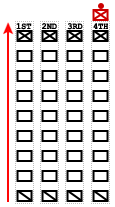
Hoplites (HOP-lites) were citizen-soldiers of Ancient Greek city-states who were primarily armed with spears and shields. Hoplite soldiers utilized the phalanx formation in order to be effective in war with fewer soldiers. The formation discouraged the soldiers from acting alone, for this would compromise the formation and minimize its strengths. The hoplites were primarily represented by free citizens—propertied farmers and artisans—who were able to afford the bronze armour suit and weapons. Hoplites were not professional soldiers and often lacked sufficient military training. However, some states did maintain a small elite professional unit, known as the epilektoi ("chosen") since they were picked from the regular citizen infantry. These existed at times in Athens, Argos, Thebes (Greece), and Syracuse, among others. Hoplite soldiers were relied on heavily and made up the bulk of ancient Greek armies of the time.

Infantry is the branch of an army that engages in military combat on foot, distinguished from cavalry, artillery, and tank forces. Also known as foot soldiers, infantry traditionally relies on moving by foot between combats as well, but may also use mounts, military vehicles, or other transport. Infantry make up a large portion of all armed forces in most nations, and typically bear the largest brunt in warfare, as measured by casualties, deprivation, or physical and psychological stress.

Military tactics encompasses the art of organising and employing fighting forces on or near the battlefield. They involve the application of four battlefield functions which are closely related – kinetic or firepower, mobility, protection or security, and shock action. Tactics are a separate function from command and control and logistics. In contemporary military science, tactics are the lowest of three levels of warfighting, the higher levels being the strategic and operational levels. Throughout history, there has been a shifting balance between the four tactical functions, generally based on the application of military technology, which has led to one or more of the tactical functions being dominant for a period of time, usually accompanied by the dominance of an associated fighting arm deployed on the battlefield, such as infantry, artillery, cavalry or tanks.
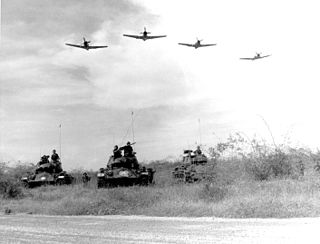
Combined arms is an approach to warfare which seeks to integrate different combat arms of a military to achieve mutually complementary effects. According to strategist William S. Lind, combined arms can be distinguished from the concept of "supporting arms" as follows:
Combined arms hits the enemy with two or more arms simultaneously in such a manner that the actions he must take to defend himself from one make him more vulnerable to another. In contrast, supporting arms is hitting the enemy with two or more arms in sequence, or if simultaneously, then in such combination that the actions the enemy must take to defend himself from one also defends himself from the other(s).

The Battle of Cambrai was a British attack followed by the biggest German counter-attack against the British Expeditionary Force (BEF) since 1914, in the First World War. The town of Cambrai, in the département of Nord, was an important supply point for the German Siegfriedstellung and capture of the town and the nearby Bourlon Ridge would threaten the rear of the German line to the north. Major General Henry Tudor, Commander, Royal Artillery (CRA) of the 9th (Scottish) Division, advocated the use of new artillery-infantry techniques on his sector of the front. During preparations, J. F. C. Fuller, a staff officer with the Tank Corps, looked for places to use tanks for raids. General Julian Byng, commander of the British Third Army, decided to combine both plans. The French and British armies had used tanks in mass earlier in 1917, although to considerably less effect.

During the American Civil War, the Union Army referred to the United States Army, the land force that fought to preserve the Union of the collective states. Also known as the Federal Army, it proved essential to the preservation of the United States of America as a working, viable republic.

Skirmishers are light infantry or cavalry soldiers in the role of skirmishing—stationed to act as a vanguard, flank guard, or rearguard, screening a tactical position or a larger body of friendly troops from enemy advances. They are usually deployed in a skirmish line—an irregular open formation much more spread out in depth and breadth than a traditional line formation. Their purpose is to harass the enemy—engaging them in only light or sporadic combat in order to delay their movement, disrupt their attack, or weaken their morale. Skirmishers' open formations and smaller numbers can give them superior mobility over the regular forces, allowing them to fight on more favorable terms, taking advantage of better position or terrain and quickly withdrawing from any threat of superior enemy forces.
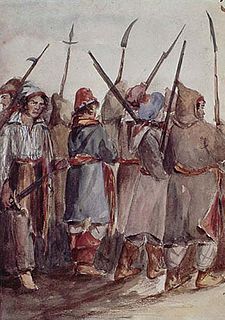
Irregular military is any non-standard military component that is distinct from a country's national armed forces. Being defined by exclusion, there is significant variance in what comes under the term. It can refer to the type of military organization, or to the type of tactics used. An irregular military organization is one which is not part of the regular army organization. Without standard military unit organization, various more general names are often used; such organizations may be called a "troop", "group", "unit", "column", "band", or "force". Irregulars are soldiers or warriors that are members of these organizations, or are members of special military units that employ irregular military tactics. This also applies to irregular troops, irregular infantry and irregular cavalry.
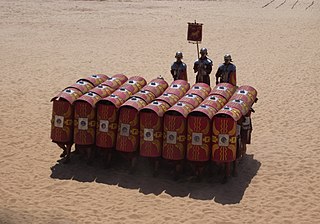
In Ancient Roman warfare, the testudo or tortoise formation was a type of shield wall formation commonly used by the Roman Legions during battles, particularly sieges. Testudo is the Latin word for "tortoise". The Greek term for this formation is "chelone" and during the Byzantine era, it seems to have evolved to what military manuals of the era called the "foulkon".
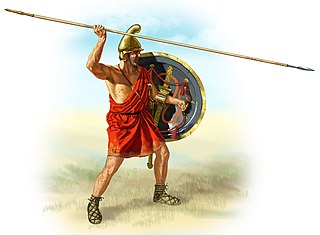
The army of the Kingdom of Macedon was among the greatest military forces of the ancient world. It was created and made formidable by King Philip II of Macedon; previously the army of Macedon had been of little account in the politics of the Greek world, and Macedonia had been regarded as a second-rate power.

The 77th Infantry Division of the British Army was formed during the Second World War, from the re-organisation of the Devon and Cornwall County Division. During its existence the division changed roles several times. On 20 December 1942, it became the 77th Infantry (Reserve) Division, training recruits in infantry and armoured warfare. New recruits to the army were assigned to the 77th to complete their training.

The 61st Infantry Division was an infantry division of the British Army, raised in 1939 as part of the expansion of the Territorial Army in response to the German occupation of Czechoslovakia. The division was created as a duplicate of the 48th Infantry Division, and was assigned to home defence duties.
The infantry in the American Civil War comprised foot-soldiers who fought primarily with small arms, and carried the brunt of the fighting on battlefields across the United States. Historians have long debated whether the evolution of tactics between 1861 and 1865 marked a seminal point in the evolution of warfare. The conventional narrative is that generals and other officers adhered stubbornly to the tactics of the Napoleonic Wars, in which armies employed linear formations and favored open fields over the usage of cover. Presumably, the greater accuracy and range of the rifle musket rendered that approach obsolete, and the Civil War armies' transition to longer battles in 1864 is taken by numerous scholars as proof of the new technology's transformative impact. More recently, however, academics have begun to reject this narrative. Earl J. Hess judges the tactical training of the Civil War as critical to the armies' success, and maintains that the dearth of overwhelming victories during the conflict was actually consistent with the infrequency of such battles throughout history. Allen C. Guelzo contends that rifle muskets did not revolutionize land warfare due to a combination of inadequate firearms training and the poor visibility caused by black powder. This debate has implications not only for the nature of the soldier's experience, but also for the broader question of the Civil War's relative modernity. Williamson Murray and Bruce Wayne Wei-Siang Hsieh argue that the conflict was resulted from "the combination...of the Industrial Revolution and French Revolution [which] allowed the opposing sides to mobilize immense numbers of soldiers while projecting military power over great distances." The Civil War involved a number of other recently-introduced and new technologies, including military balloons, repeating rifles, the telegraph, and railroads.
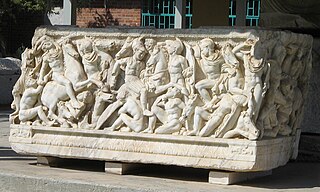
The Hellenistic armies is the term applied to the armies of the successor kingdoms of the Hellenistic period, which emerged after the death of Alexander the Great. After his death, Alexander's huge empire was torn between his successors, the Diadochi. During the Wars of the Diadochi, the Macedonian army, as developed by Alexander and Philip II, gradually adopted new units and tactics, further developing Macedonian warfare and improving on the tactics used in the Classical era. The armies of the Diadochi bear few differences from that of Alexander, but during the era of the Epigonoi, the differences were obvious, favoring numbers over quality and weight over maneuverability. The limited availability of Greek conscripts in the east led to an increasing dependence on mercenary forces, whereas in the west, Hellenistic armies were continuously involved in wars, which soon exhausted local manpower, paving the way for Roman supremacy. The major Hellenistic states were the Seleucid Empire, Ptolemaic Egypt and the Antigonid kingdom (Macedonia). Smaller states included: Attalid Pergamum, Pontus, Epirus, the Achaean League, the Aetolian League, Syracuse, and other states.
Military art is a field of theoretical research and training methodology in military science used in the conduct of military operations on land, in the maritime or air environments. Military art includes the study and application of the principles of warfare and laws of war that apply equally to the closely interrelated military strategy, operational art and tactics. Exercise of military art is highly dependent on the economics and logistics supporting the armed forces, their military technology and equipment, and reflects the social influences on the military organisation exercising military art. Often misunderstood due to its 19th-century perception as generally "including the entire subject of war", it is primarily, as the term implies, the expression of creative thinking on the part of the decision-makers in employing their forces, with the map of the area of operations as a veritable canvas, and the movement of forces commonly marked on the map with arrows, as brush strokes. Less imaginatively it was defined in France during the 19th century as
The art of war is the art of concentrating and employing, at the opportune moment, a superior force of troops upon the decisive point.
The 1st Regiment Greek Light Infantry (1810–12) was a light infantry regiment, founded as a local establishment in British service consisting mostly of Greek and Albanian enlisted men and Greek and British officers that served during the Napoleonic Wars. Later it became a regular British Army regiment as the 1st Greek Light Infantry (1812–16). It had no official association with the modern state of Greece or the Filiki Eteria or any Greek War of Independence groups; however, several future leaders of the War of Independence fought in its ranks, as did a number of rank-and-file klephts and armatoloi.

Henry Boynton Clitz was a career United States Army officer who served with distinction in the Mexican–American War and in the Union Army during the American Civil War. He received brevet appointments for his service in both wars. After his release as a prisoner of war from the Confederate Libby Prison in Richmond, Virginia on July 17, 1862, he was Commandant of Cadets at the United States Military Academy at West Point, New York, from October 23, 1862 to July 4, 1864. Clitz was nominated and confirmed for appointment as a brevet brigadier general in the Regular Army on March 2, 1867 to rank from March 13, 1865. He retired from the Regular Army as colonel of the 10th Infantry Regiment on July 1, 1885. Clitz, whose deteriorating mental state had been noticed by relatives for several months, disappeared at Niagara Falls, New York, and was presumed drowned on October 30, 1888.

